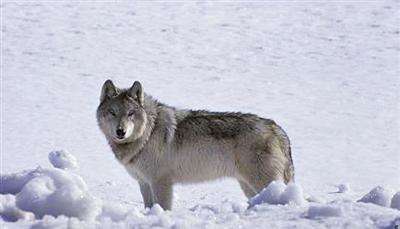
We already have busted Ranchers and Hunters Myths, stories and fairy tales 😉 but it is good to see Biologists that aren’t scared of peer pressure, do it as well.
Wolves live in family groups. They don’t think twice about traveling long distances. They’re territorial. They make a lot of noise. And some have no qualms about capturing and killing their foes.
In other words, they’re a lot like humans.
Contrary to the host of conspiracy theories out there, wolves in northwest Montana aren’t hybrids and they weren’t shipped in from points north. They came here on their own volition back in the late 1970s, stragglers from Canada that eventually made the North Fork of the Flathead in Glacier National Park home, biologist Diane Boyd said during a talk last week.
Boyd began her career doing wolf research in Minnesota in the 1970s. In the 1930s the gray wolf was killed off in 98 percent of its historic range in the Lower 48. Minnesota held a few wolves at that time.
She came to Montana in the fall of ’79 and worked with wolf researcher Bob Ream, studying the Magic pack — the storied first descendants of Northwest Montana’s wolves — and has studying wolves in one way or another ever since.
Today, Boyd is the wolf carnivore specialist for Montana Fish, Wildlife and Parks. Her talk looked to clear the air, so to speak, on the iconic creatures, and dispel some myths along the way.
Wolves are highly adaptable creatures. They range from the Arctic Circle south to the Gaza Strip in the Middle East.
“They can live anywhere,” she said.
A wolf will eat just about anything with four feet. Wolves in Minnesota, for example eat a lot of deer, but they also eat a lot beavers. Locally, wolves dine on deer and elk primarily, They do best in habitat that supports large ungulate populations and that have large open spaces. It doesn’t have to be wilderness, she noted. A typical wolf will cover a lot of ground. Home ranges are typically about 230 square miles or so, and it’s not uncommon for dispersal wolves to travel hundreds of miles. One study wolf that was collared in Northwest Montana was shot in Canada some 550 miles to the north.
The local population got its roots in the North Fork of Glacier National Park. The first den in the park was near Doverspike Meadow in 1986.
By 1987 the Magic Pack had 11 inhabitants in a meadow not too far south from Doverspike. Wolves still den there today.
In those early days, Boyd trapped and collared wolves and then tracked them by ground and air with the help of a host of volunteers.
“Following an animal in the snow is the biggest privilege I’ve had in my life,” she said.
It was challenging work at time. Biologists didn’t have the high-tech tools they have today. There was no GPS. No cell phones. No DNA. On one overflight they finally found a wolf they had been looking for way up in Canada.
They spotted the wolf, but had no idea where they were, so the pilot buzzed down to the highway and Boyd wrote down the roadside signs to figure out their location. The federal government accelerated wolf recovery when it reintroduced wolves to Yellowstone National Park from 1995-97.
Boyd and Ream both opposed it. She noted wolves were already well on their way to dispersing to the region from Northwest Montana on their own. The reintroduction resulted in a lot of resentment toward the animals.
By 2002 wolves were biologically recovered and by 2011 they were delisted from the Endangered Species Act in Montana, Idaho and eventually, Wyoming.
In 2017 it was estimated there were a minimum of 633 wolves in 124 packs with 63 breeding pairs in the state. A breeding pair is defined as two adults with two pups of the year that survive until December.
All told, hunters and trappers took 255 wolves in 2017 alone.
“If you would have asked me in 1979 if we would be hunting wolves (by today) I’d have said no … nevermind 255.”
The recovery of the species,she noted is one of the major success stories of the Endangered Species Act. She noted that the recent move to delist them in the Lower 48 has no bearing on Montana, but it could have an impact on wolves where they have far fewer numbers, like Washington, Oregon, Nevada and California.
True, wolf eat deer and elk, but she also pointed to a graph that showed wolf numbers peaked in 2011 and deer harvest by hunters was at a peak at the same time. Though there have been dips in deer populations as of late, biologists blame the biggest baddest force of all — the weather.
The real killer of deer is bad winters, Boyd noted.
“Wolves don’t drive deer to extinction,” she said. There are a lot of factors in play when it comes to game populations, including habitat loss, other predators like grizzly bears and people running over them with their cars.
Still, the illegal taking wolves as of late has been on the rise as vitriol toward the wolf appears is on the increase, even though research has shown that there are many more mountain lions on the landscape, a far more efficient predator that eats a lot of deer.
Boyd suggests people tolerate lions because they’re quiet and sneaky. Aside from tracks in snow, they’re rarely seen or heard.
Wolves are loud and boisterous with their howling and barking and they like to run the roads, leaving plenty of tracks behind.
“When wolves come through an area it’s like a pack of Harleys,” she said.
She notes a quote from longtime wolf researcher Dave Meech.
“The wolf is neither the devil nor saint except in the eye of the beholder.”
Comments
Thanks didnt know